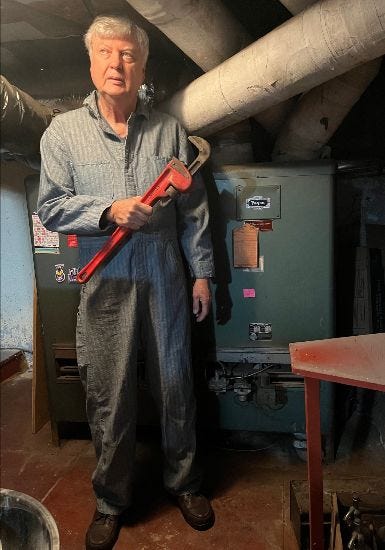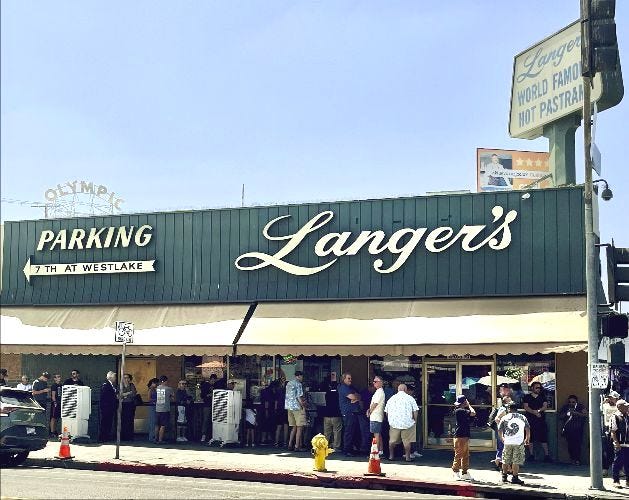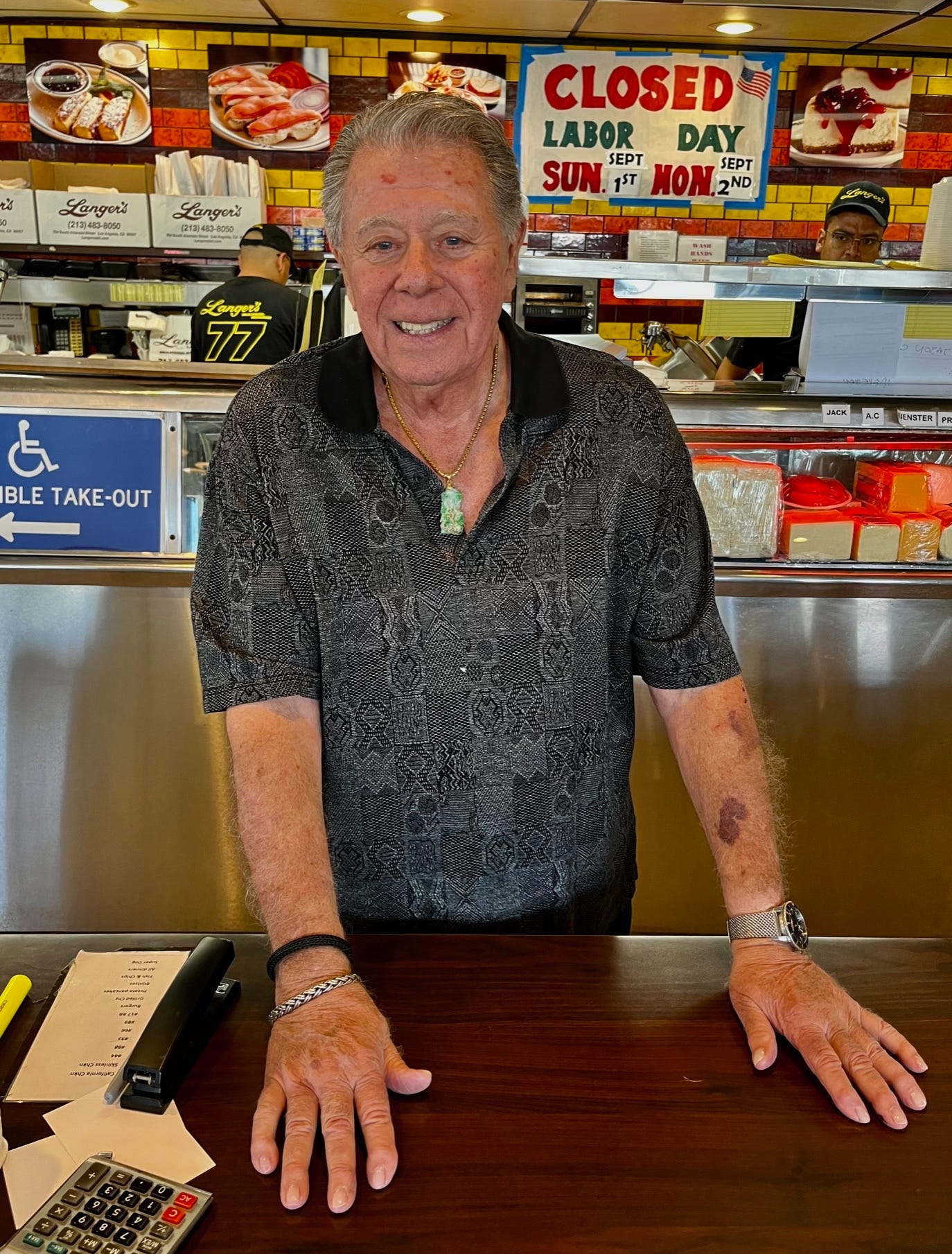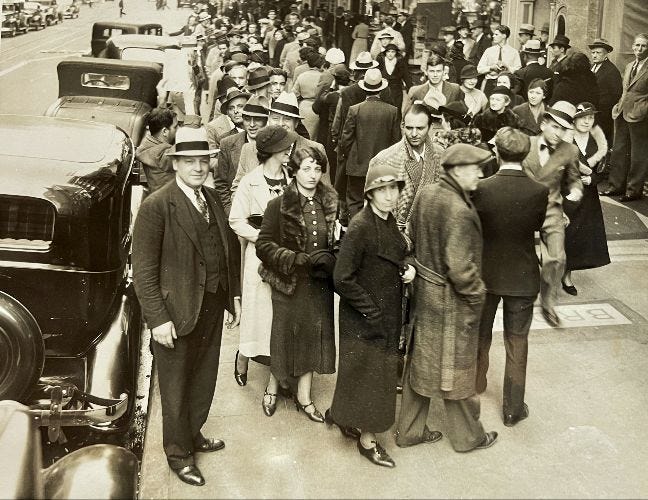Can Pastrami Save LA?
A New Scroll of LA Jewish News
Folks,
Labor Day does not usually appear on the Jewish calendar, but it should. As a way of observing the day, I’m wearing coveralls made by the Edward Hyman Company, an LA firm of nationally distributed union-made workwear, started by a former New Yorker who came to LA in the early 1920s.
Putting on the workwear helped me to remember, in a time when Jews have become managers, professionals, and entrepreneurs, that many Jewish families have benefited from organized labor.
My own grandmother, who was a garment inspector, and step-grandfather, who worked in a brewery, benefited from the wages and workplace standards established by the unions.
A well-paying union job in a bottling plant, I had one summer, helped me to earn money for college. And when our children were young, my wife had a union job–good pay, health benefits, and a paid vacation–which on Labor Day, I will remember, helped our union to endure.
Now, here’s your job. If you are not a paid subscriber, especially if you have been reading free, come on, it’s time to remember my labor. Please subscribe today.
Shabbat shalom
Edmon J. Rodman
////\/\\\\
////\/\\\\
Can pastrami save LA?
Edmon J. Rodman
For the sake of a pastrami sandwich, can a neighborhood be saved?
On the front page of last Sunday’s Los Angeles Times, leading into Steve Lopez’s column, was this uh-oh of a headline: “Langer’s DeIi Owner hungers for a MacArthur Park cleanup.”
“I’m considering closing,” Norm Langer, the owner of the landmark deli told Lopez. “It’s a strong consideration.”
After years of trying to get the city to clean up the area’s rampant drug use, sales, and overdoses, many of them fatal, on its streets and alleys. Langer, age 77, was “tired of pushing the cart up the hill,” said the column.
Did this mean that Langer’s was seeing its final days?
If you have been living under a slice of Wonder bread the last six decades or so, Langer’s is the go-to spot for pastrami sandwiches in LA. Most recently, in 2019, Langer’s, was named a Michelin Guide Bib Gourmand honoree.
Beyond that, the Jewish-style deli, famous for its tender beef and double-baked rye bread, (on several occasions, I have gone in to pick up a loaf) is a cornerstone of the once very Jewish Westlake neighborhood.
Today, the neighborhood is mainly Latino, with the surrounding streets packed with sidewalk vendors. Reminding me of the historic photos I have seen of Hester Street in New York’s Lower Eastside, the vendors are only a small part of the problem.
Though the intersections are often filled with the pleas of sidewalk preachers, drug use, crime, and overdose death, lie in the alleys and side streets just beyond the storefronts.
Twenty-five years ago, when my children were younger, I once took them to nearby MacArthur Park for a lake boat ride. Even then, the shadow of the creeping crack epidemic was creeping into this once peaceful area.
With the increase in crime, Langer’s stopped opening for dinner. If it were not for the opening of the Westlake/MacArthur Park station of the Metro Rail Red Line in 1993, allowing sandwich-seekers to travel from downtown to less than a block away from the deli, Langer’s may have closed.
By 2013, when my wife and I attended a concert in MacArthur Park, where songwriter Jimmy Webb was performing his classic “MacArthur Park,” you could see that more than just the cake had been left out in a rain of drugs. Police were everywhere trying to keep the users on the fringe of the concert area.
In recent years, the drug of choice has been fentanyl. Reporting on this new drug epidemic, in 2023, a Los Angeles Daily News article said “83 fatal overdoses occurred in the zip code encompassing MacArthur Park.”
“Our small businesses are struggling, the selling of narcotics on the streets, illegal vendors, the potholes, the streets that need cleaning, the shoplifting by the Metro station,” MacArthur Park Neighborhood Councilmember Ivonneanette Machado told the Daily News.
Norm Langer was struggling too, and wonder of wonders, his geschrei in the Times went up to the ears of the mayor. On the Tuesday after the column’s publication, Mayor Karen Bass showed up for lunch at the imperiled deli.
According to Steve Lopez’s second column about the plight of Langer’s, Norm told him that the mayor “had already spoken to L.A. police officials,” and had texted Councilwoman Eunisses Hernandez, who represents the area, about the problem.
Was the menu of promises that Langer had seen before about to turn a page?
On Thursday of that week, as I drove by Langer’s, the line on the 7th street side of the restaurant told me that I was not the only one alarmed about the possibility of Langer’s closing.
Generations of Angelenos have loved eating at Langer’s, but it seems that the threatened closure of this landmark had initiated a craving for more than just nostalgia for days gone by. A line of something had been laid down; not relish, or mustard, but the stuff that makes human connections, and holds a city together.
Norm Langer
“There’s about 50 people today, and yesterday there was around 80,” Norm Langer told me, as he stood behind the deli counter. He had been unusually busy since the story broke, and was still in motion when I found him. But, when I asked him if he was happy with the results of Times interview, he stopped.
“I had a meeting this morning at 9 o’clock with our mayor Karen Bass and Eunisses Hernandez our councilwoman,” he said. “They both promised to take care of for what I have asked for the area, as for cleaning up 7th street,” he said, with more than a tone of excitement.
“They said, ‘give them a couple of weeks to get it done,’" said Langer, "and I said that’ll work.” So, “as of this morning at 9 o’clock, it was all extremely positive,” he said smiling.
After decades of decline, neglect, and plays to improve the area gone awry, could a city’s love for two slices of rye bread with seasoned meat slapped in between be the impetus for change and renewal?
Especially after a pandemic, we crave the group experience, the sitting down together, the opportunity to see each other enjoying a meal. Maybe Langer’s is the sandwich we have been looking for; the one we don’t want to go.
////\/\\\\
Moving High Holy Days
The Movable Minyan, Los Angeles’ oldest independent, lay-led, and egalitarian Jewish prayer community, will be holding High Holy Day services at the J, formerly the Westside Jewish Community Center.
This year, the group will be discussing Rabbi Alan Lew’s thought-provoking book on understanding the High Holy Days “This is Real and You Are Completely Unprepared.”
In the middle of the organization’s 36th anniversary year, the minyan’s services feature group singing, prayer and discussions, followed by a communal meal.
For more info click HERE.
////\/\\\\
Film Review:
The healing of two temples
Sony Pictures
Edmon J. Rodman
At its heart and head, “Between the Temples,” a new film starring Jason Schwartzman and Carol Kane, is about a young cantor who has lost his song and how he recovers it.
Opening in late summer, as we approach the holiest days of the Jewish year, days in which we seek healing, the movie, directed by Nathan Silver, in its own comic/serious way, presents a few crucial moments of hope.
Cantor Ben Gottlieb’s wife has died in an accident, and a year later, though he tries, he is unable lead services at the small-town Jewish synagogue where he works. On Friday night, the cantor opens his mouth to sing Yedid Nefesh, meaning “beloved of the soul,” or soul mate, and no music comes out.
He has lost more than his voice.
After a suicide attempt, too many Mudslides, and a one-punch fight in a bar, he meets an unlikely soul mate: a wonderfully unhinged older woman, Carla O’Connor (Carol Kane), who has been let go from a multi-decade teaching career and is also suffering. Turns out, she was Ben’s elementary school music teacher.
A few scenes later, Carla (whose maiden name was Kessler) comes to the synagogue where Cantor Ben is teaching a b’nei mitzvah class, and asks if she can have a bat mitzvah. One of the major themes of the High Holy Days is teshuva, repentance, or returning, and this is where the lives that the film explores, the young cantor and the senior teacher, begin to return to a semblance of their former forms.
At first, a film-goer may mistake “Between the Temples” as a kind of flip re-make of “Harold and Maude.” A younger teacher and older bat mitzvah student do become close, and eventually profess a kind of love, but this is not a May-December romance; more like two souls desperately trying to recover from a dark winter.
Sitting in the West LA theater, I wondered how these scenes were playing to what appeared to be a mostly older Jewish audience; a group who had undoubtedly experienced their own tragedies.
Struck in the temple both physically and spiritually, how had we recovered? How had we regained our connection to the things in life that brought us joy and meaning? Was recovery brought on by retracing a successful pattern? Falling into something new? A bissel this, and a bissel that?
Sony Pictures
Ben is a reluctant teacher. He understands that teaching Carla Torah threatens his song-less state of mind. Yet with Carla’s persistence, and a push from his boss, the synagogue’s rabbi, he gives in.
We watch as Ben brings joy to Carla by teaching her how to chant her Torah portion (it was his portion too), and Carla coaches Ben on how to relax, and shows him an exercise that can breathe life back into his singing voice.
There are moments in the movie, where like an unsure bar mitzvah boy, it almost loses its voice. Satirical scenes about Holocaust event fundraising, and a rabbi whose Higher Source seems to be congregant donations, crack and sputter.
A scene about Ben’s level of kashrut, comically demonstrates how even “observant” Jewish Americans pick and choose their level of observance. Who actually uses JDate is also given a humorous answer.
There is one subject where the film’s voice is as clear as an operatic soprano. Based, in part, on the story of the director’s mother, Cindy Silver, who pursued her own adult bat mitzvah, the movie explores, how even later in life, Jewish communal learning can change one’s existence.
In the film, Carla mentions how in 1922, Judith Kaplan, the daughter of Rabbi Mordecai Kaplan, was the first American woman to celebrate a bat mitzvah. Even with that precedent, change came slowly, and many Jewish women who grew up in the 1950s and early 60s, either were told a bat mitzvah was not possible, or were discouraged from pursuing one.
Ben’s move towards regaining his voice, is not the only returning in “Between the Temples.” Even late in life, Jewish women too, can find their voice.
////\/\\\\
* Live from the Archive:
Hats off to unions
This Labor Day, we tip our hats to LA’s unionized milliners from around 90 years ago. At that time, when wearing a hat for both men and women was the fashion of the day, and hat-making was important, the business was the livelihood of many Jews.
Most of the hat-making businesses were owned by Jewish businessman, and many of the milliners were Jewish too, as was their union leadership.
In 1935, agitated over a refusal by management to consider the establishment of an arbitration board empowered to rule on employee discharges, around 1200 members of the Millinery Workers’ Union went out on strike a few weeks before Easter, the peak of the hat-buying season.
The photo above shows the milliners picketing on Broadway, between 6th and 8th streets, where many of the 42 hat manufacturers had their workshops and showrooms. Fortunately, no violence occurred on the line.
After a week of picketing, during which the manufacturers tried to bring in non-union workers, both sides agreed to a one-year truce. An agreement had already been reached on an adjustment in pay, and union workers were offered their jobs back.
*The Rodman Archive of Los Angeles Jewish History is a collection of approximately 1000 objects, photos, clothing, art, books, recordings, and ephemera relating to the lives and endeavors of Jewish Angelenos between 1850 and 1980.
////\/\\\\
Seen on the way: Pico-Robertson
In the U.S., the Israel-Hamas War is beginning to have an impact well-beyond the usual ideological forces that either praise or condemn Israel. As seen on this placard found leaning against a Robertson Avenue storefront, the war, in the guise of a first-grade teacher speaking about “Palestinian Genocide,” is being dropped into the battle over the funding of Jewish education. Raisethon.com is a digital fundraising site, and a Los Angeles Jewish educational non-profit called Yad Menachem, whose mission “is to help give Jewish children access to Jewish education by helping their parents pay for tuition” is the fundraiser. Their plan of attack may be working. According to the Raisethon site, the campaign has brought in over $321,000, 7% over the original goal.
////\/\\\\











